The Huawei MateBook 16 Review, Powered by AMD Ryzen 7 5800H: Ecosystem Plus
by Dr. Ian Cutress on October 20, 2021 8:00 AM EST- Posted in
- Laptops
- AMD
- Huawei
- Matebook
- Ryzen
- Zen 3
- MateBook 16
- Huawei Share
- Ryzen 7 5800H
Power and Storage Performance
The processors used in the MateBook 16 are the latest Zen 3 based AMD Ryzen Mobile parts that exist as part of AMD’s H-Series range. The H-series, both on the side of AMD and Intel, typically run with a 45 W thermal design power (TDP) by definition, although depending on the mobile device being used, the manufacturers can adjust that TDP either up or down, given the desired cooling, performance, and battery life.
| AMD Ryzen 5000 Mobile: H-Series | |||||
| AnandTech | Cores Threads |
Base Freq |
Boost Freq |
TDP Default |
Vega |
| Ryzen 9 5980HX | 8C / 16T | 3300 | 4800 | 45W+ | Vega 8 |
| Ryzen 9 5980HS | 8C / 16T | 3000 | 4800 | 35W | Vega 8 |
| Ryzen 9 5900HX | 8C / 16T | 3300 | 4600 | 45W+ | Vega 8 |
| Ryzen 9 5900HS | 8C / 16T | 3000 | 4600 | 35W | Vega 8 |
| Ryzen 7 5800H | 8C / 16T | 3200 | 4400 | 45W | Vega 8 |
| Ryzen 7 5800HS | 8C / 16T | 2800 | 4400 | 35W | Vega 8 |
| Ryzen 5 5600H | 6C / 12T | 3300 | 4200 | 45W | Vega 7 |
| Ryzen 5 5600HS | 6C / 12T | 3000 | 4200 | 35W | Vega 7 |
Typically the TDP setting of a mobile processor isn’t just a ‘suggestion’ as with some of the desktop hardware: the power limit imposed by the TDP comes up very quickly after a few seconds of heavy loading, or even straight away for the slimmest of designs that are not designed for high thermal hotspots. As a result, we’re in a situation where looking at the processor name on a laptop or notebook means next to nothing for performance, and instead we need to look at the power use in a variety of scenarios. One day I hope that laptop vendors will list the configured power window for the processors they have tuned, but I don’t see it coming any time soon.
In this case, Huawei is using the Ryzen 7 5800H in our MateBook 16 unit: an 8-core, 16-thread processor with Vega 8 graphics. It has a nominal thermal design power of 45 W, but Huawei has configured it to run at 35 W. When run in this mode, the turbo frequencies are usually the same as the higher power mode, but when the system clamps on the maximum power, the all-core frequency is reduced to get to that level. The added bonus of this, aside from maintaining comfortable thermals on the device, is also that the processor runs nearer its peak efficiency point.
Huawei further spices it up by offering a PERFORMANCE mode. If the laptop is plugged into the wall with its 135 W charger, performance mode can be activated which allows individual cores access to the full 35 W. In all-core use, we see that the turbo time is increased, keeping the whole processor at 35 W for longer. The goal here is extra long-term performance, which we see in our testing in benchmarks that are long and compute-heavy, although we fail to see much benefit in gaming or day-to-day tasks.
To showcase this, we start with a traditionally heavy workload in Prime 95.
In this test, the Performance mode spikes at 52 W when the test begins, but then very quickly comes down to 35 W, which it continues all the way to the end of the test. By contrast, in the default balanced mode, we get 35 W for about 3 minutes, and then the processor scales back to 30 W.
Interestingly enough, we don’t see the same issue in Handbrake:
In this case both processors perform equally for the duration of the test, staying at 35 W, except for that initial 57 W spike when in performance mode. The test in this case took an identical amount of time to complete.
Agisoft is one of my tests that is more varied in the threaded workload, with a mix of all-core and single core tasks, and we see a can see a considerable different in the performance between the two modes.
I’ve adjusted the x-axis to % of benchmark complete, because the Performance mode completes the test about 6% quicker.
Here we see that the Performance mode stays at 35 W for most of the test, until the last 15% which is more single-threaded. The Balanced mode gets knocked back almost immediately to 30 W, before reducing further to 20 W. The whole test takes around 20 minutes, and the Balanced came down to 20 W around the 14-minute mark. But overall, the performance mode was quicker, at the expense of extra power.
Storage Performance
The MateBook 16, regardless of which model you buy, will come with 16 GB of DDR4-3200 and a 512 GB NVMe SSD inside. The storage in our laptop is a Samsung PM981a, which is the same PCIe 3.0 x4 drive that Huawei has been putting inside its laptops for at least two generations, if not three. It’s still a good performer, and compared to the 1 TB version we saw in the MateBook X Pro in our previous review, it is a tiny bit faster.
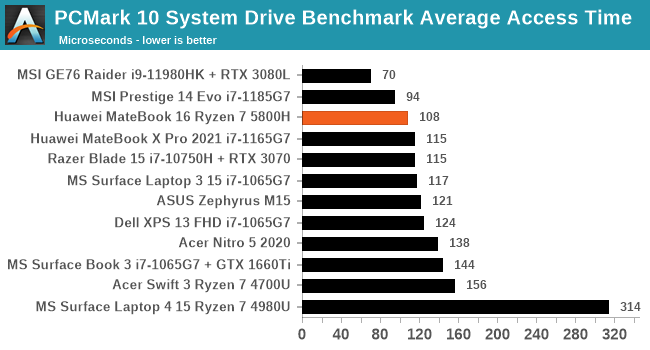
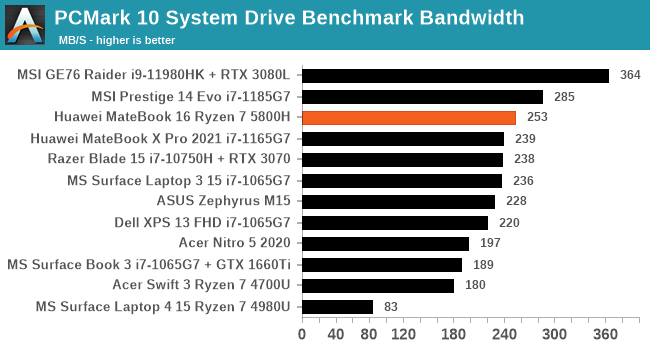
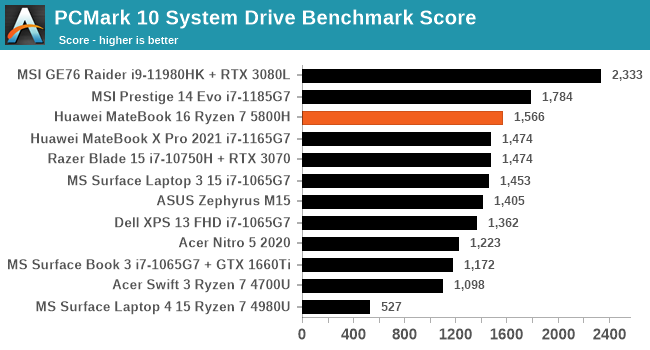
While Huawei continues to use the lowest SKU of the respective stack, such as the lowest Core i7 in the Core i7-1165G7 for the MateBook X Pro and the lowest Ryzen 7 for the Ryzen 7 5800H in the MateBook 16, there isn’t much reason for them to use anything other than the PM981a, as it remains a good drive.



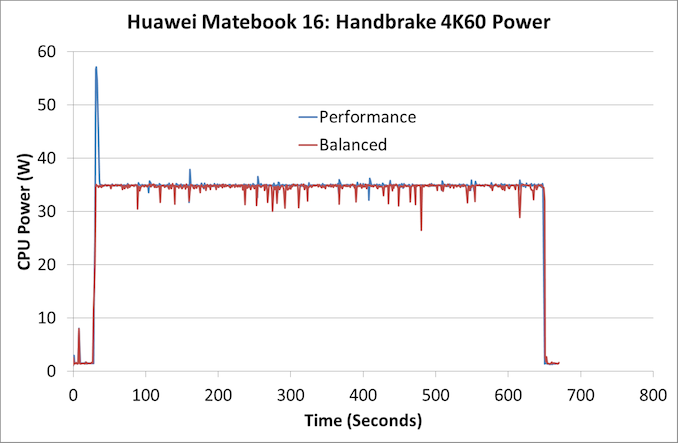
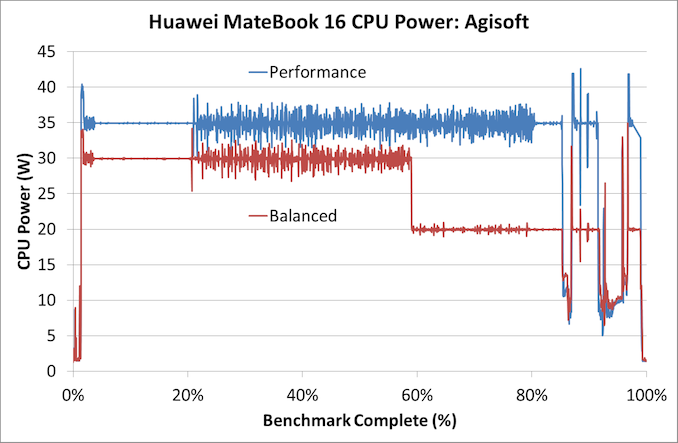








87 Comments
View All Comments
TheinsanegamerN - Wednesday, October 20, 2021 - link
Good to see another company jump on the "use a 45w ryzen chip without a dGPU" train, letting that iGPU stretch its legs a bit mroe. Shame it limits TDP so much, the mechrevio1 is a similar laptop that doesnt do that, rather allows up to 54 watt. But the huwaei has that gorgeous 16:10 display.....We need mroe of these types of laptops, and less of the dell/HP/lenovo garbage weve been getting.
at_clucks - Thursday, October 21, 2021 - link
We would have had a Kirin M1-like CPU soon if Huawei wasn't targeted by the restrictions on using US tech. Somehow those restrictions don't apply when buying straight up from Qualcomm or AMD, only when competing with them.So while I love to see mobile devices based on AMD CPUs, I would very much have loved even more to see a proper ARM SoC in there, giving M1 a run for its money. SOmething that's not tied to MacOS for example. And no, I don't consider ARM Surfaces to be that.
Arsenica - Thursday, October 21, 2021 - link
Nah, Huawei only licensed IP cores straight from ARM.At most they would have an Exynos 2000 equivalent (Cortex X1 and Mali G78 cores).
blanarahul - Wednesday, October 20, 2021 - link
"I’m a fan of notebooks that promise good power and battery life at the expense of graphics.""I have some software in my daily toolset that doesn’t work on either, so until then, I’m still focused on devices built with AMD or Intel."
Cannot agree more. I recently got a gaming notebook and while having a discrete GPU is nice, having a modern processor that is allowed to consume up to 30-40 watts and strech its legs makes a world of difference in terms of responsiveness in the applications I need to use on a day to day basis (which cannot run on Linux or Mac).
I wonder what difference Alder Lake will make with its 6 P + 8 E cores design to responsiveness and battery life.
Alistair - Wednesday, October 20, 2021 - link
and yet I've been trying to sell my top of the line CPU laptop (Ryzen 4800H) for $650 (it has a 1650 ti) and you'll find nobody wants it, I think gaming has taken over the vast majority of the market, CPU aficionados tend to have less computer knowledge, and think any Intel quad core is the same as an AMD 8 coreMccaula718 - Wednesday, October 20, 2021 - link
Your Zen 2 cpu is not top of the lineat_clucks - Thursday, October 21, 2021 - link
That's not really the problem, it's close enough to it when it comes to AMD's mobile lineup. But most people have no brand awareness when it comes to AMD, and Intel has a much more powerful brand that will attract regardless of actual performance standing, even price. And futhermore, these days a 5 year old decent laptop still does the job fine for regular day to day things. So the market for midrange new laptops (meaning not cheap low end, not superfast high end) might be smallish.You can't get a proper PC GPU so you go for the next best with a mobile GPU where the whole device is still cheaper than the PC GPU. Or you get a cheap laptop that does browsing and the likes. The offer presented above is smack in the middle.
Alistair - Thursday, October 21, 2021 - link
the 4800h was the best CPU you could buy a year ago, now it is second best, yes it isblanarahul - Thursday, October 21, 2021 - link
In my entire social circle, I am the only one who knows AMD makes excellent CPUs and GPUs as well. They all think Intel is the only one who makes CPUs (for laptops) and Nvidia is the only one that makes dGPUs. They find AMD to be "sketchy". It is upsetting but it is what it is.AMD needs to succeed in consoles and workstation/server market because as much as I hate it, Windows + Intel + Nvidia is just too powerful a combo (in terms of market presence) in the mainstream consumer market.
Alistair - Thursday, October 21, 2021 - link
exactly, that's the problem, someone actually thinks the 11400h is faster than the 4800h for example :/